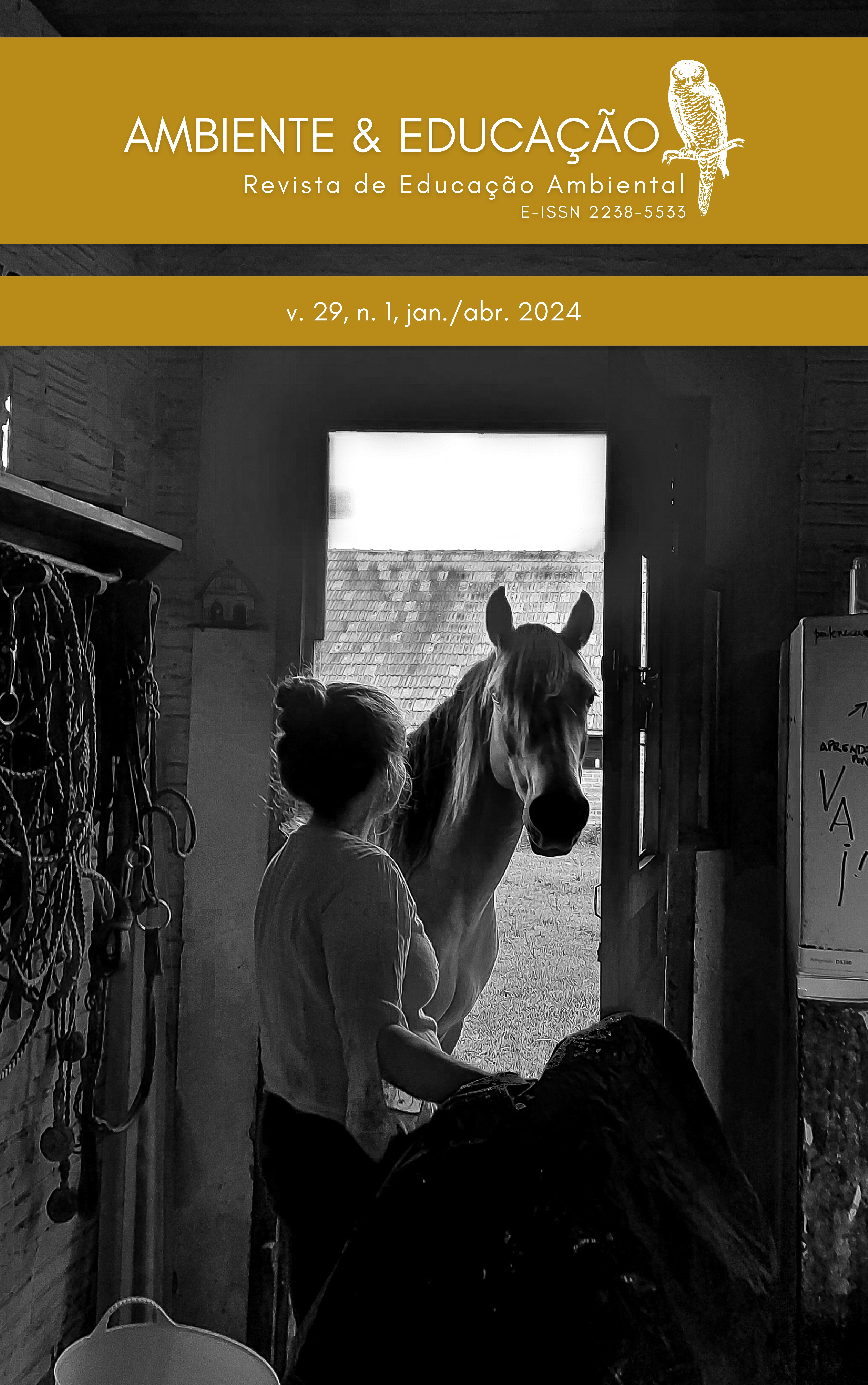Monitoramento de CO² em ambientes internos escolares e sensibilização sobre as problemáticas ambientais pós-pandemia
DOI:
https://doi.org/10.63595/ambeduc.v29i1.16362Keywords:
Conhecimento para a ação, Qualidade do ar interno, Saúde Pública, Educação AmbientalAbstract
Environmental Education (EE) plays a crucial role in bridging the gap between knowledge and action, and the COVID-19 pandemic has highlighted the importance of informed actions to combat airborne diseases. This work is a case study on the University of Calgary, Canada, focusing primarily on Carbon Dioxide (CO2) monitoring to promote EE in indoor educational settings and recommendations for the use of CO2 monitoring in classrooms. The urgency to contain the spread of airborne infections demands a broader understanding of the role of CO2 in air quality and health. Monitoring CO2 in indoor environments can enhance this understanding, inform mitigation strategies, and hold institutions accountable for providing safe environments.
Downloads
References
BAKER, Z.; GEHLBACH, H. Policy Dialogue: teaching environmentalism on a warming planet. History of Education Quarterly, v. 62, n. 1, p. 107-119, fev. 2022. Cambridge University Press (CUP). http://dx.doi.org/10.1017/heq.2021.56.
BOOTH, A. Formulating answerable questions. Evidence-Based Practice for Information Professionals, p. 61-70, 15 mar. 2004. Facet. http://dx.doi.org/10.29085/9781856047852.007.
BUTTERFIELD, A.; LE, K.; KELLY, K.; GOFFIN, P.; BECNEL, T.; GAILLARDON, P. Citizen Scientists Engagement in Air Quality Measurements. In: ASEE ANNUAL CONFERENCE & EXPOSITION, 125., 2018, Salt Lake City. Proceedings Salt Lake City: American Society for Engineering Education, 2018. p. 1-14.
CONRAD, C. C.; HILCHEY, K. G. (2010). A review of citizen science and community- based environmental monitoring: issues and opportunities. Environmental Monitoring and Assessment, v. 176 (1-4), 273-291. http://dx.doi.org/10.1007/s10661-010-1582-5.
CORSI R., MILLER, S.L., VANRY, M.G., MARR, L.C., CADET, L.R., POLLOK, N.R., MICHAELS, D., JONES, E.R., LEVINSON, M., LI, Y., MORAWSKA, L., MACOMBER, J., ALLEN, J.G. Designing infectious disease resilience into school buildings through improvements to ventilation and air cleaning. Report of the Lancet COVID-19 Commission Task Force on Safe Work, Safe School, and Safe Travel. https://covid19commission.org/ safe-work-travel. Abr 2021.
COVIDSafe Campus. University of Calgary. Calgary, Alberta, Canada. 2022. Disponível em: https://www.ucalgary.ca/risk/emergency-management/covid-19-response/covidsafe-campus. Accesso em: 17 nov. 2023.
DEY, T., ELSEN, I., FERREIN, A., FRAUENRAT, T.; REKE, M.; SCHIFFERr, S. (2021). CO2 Meter: a do-it-yourself carbon dioxide measuring device for the classroom. In: The 14Th Pervasive Technologies Related to Assistive Environments Conference, 1(1), 1-164. http://dx.doi.org/10.1145/3453892.3462697.
DÈON, J.C., STIRCHAK, L.T., BROWN, A.; SAIFUDDIN, Y. (2020). Project-Based Learning Experience That Uses Portable Air Sensors to Characterize Indoor and Outdoor Air Quality. Journal of Chemical Education, 98(2), 445-453.
http://dx.doi.org/10.1021/acs.jchemed.0c00222.
DI GILIO, A.; PALMISANI, J.; PULIMENO, M.; CERINO, F.; CACACE, M.; MIANI, A.; GENNARO, G. CO2 concentration monitoring inside educational buildings as a strategic tool to reduce the risk of Sars- CoV-2 airborne transmission. Environmental Research, v. 202, p. 111560, nov. 2021. Elsevier BV. http://dx.doi.org/10.1016/j.envres.2021.111560.
DUNLOP, L. Teacher and youth priorities for education for environmental sustainability: a co-created manifesto. British Education Research Journal, [s. l], v. 4, n. 5, p. 952-973, abr. 22.
ELLENBURG, J.A.; WILLIFORD, C.J.; RODRIGUEZ, S. L.; ANDERSEN, P. C.; TURNIPSEED, A.; ENNIS, C.; BASMAN, K. A.; HATZ, J. M.; PRINCE, J. C.; MEYERS, D. H. (2019). Global Ozone (GO3) Project and AQTreks: use of evolving technologies by students and citizen scientists to monitor air pollutants. Atmospheric Environment: X, 4, 100048. http://dx.doi.org/10.1016/j.aeaoa.2019.100048.
ESCHENBACH, E. A.; CASHMAN, E. M. Introduction to Air Resources: just in time! In: Proceedings of the 2004. American Society for Engineering Education AnnualConference & Exposition. Humboldt: American Society for Engineering Education, 2004. p. 1-8.
FJUKSTAD, B.; ANGELVIK, N.; HAUGLANN, M. W.; KNUTSEN, J. S.; GRØNNESBY, M.; GUNHILDRUD, H.; BONGO, L. Low-Cost Programmable Air Quality Sensor Kits in Science Education. Proceedings of the 49Th Acm Technical Symposium on Computer Science Education, v. 1, n. 1, p. 1-20, 21 fev. 2018. ACM. http://dx.doi.org/10.1145/3159450.3159569.
FJUKSTAD, B.; ANGELVIK, N.; GRONNESBY, M.; HAUGLANN, M. W.; GUNHILDRUD, H.; RASCH, F. H.; IVERSEN, J., DALSENG, M.; BONGO, L. A. Teaching Electronics and Programming in Norwegian Schools Using the air. Proceedings of the 2019 Acm Conference on Innovation and Technology in Computer Science Education, 1(1), 952- 164, 2018. http://dx.doi.org/10.1145/3304221.3325527.
FLETCHER, R. Inside these parents’ long, nerdy struggle over how to improve air quality in Calgary schools. 2023. CBC - Canadian Broadcasting Corporation. Disponível em: https://www.cbc.ca/newsinteractives/features/calgary-parents-campaign-school-air-quality. Acesso em 04 jul. 2023.
GROSSBERNDT, S.; PASSANI, A.; LISIO, G.; JANSSEN, A.; CASTELL, N. Transformative Potential and Learning Outcomes of Air Quality Citizen Science Projects in High Schools Using Low-Cost Sensors. Atmosphere, 12(6), 736, 2021
http://dx.doi.org/10.3390/atmos12060736.
JAMES, K. L.; RANDALL, N. P.; HADDAWAY, N. R. A methodology for systematic mapping in environmental sciences. Environmental Evidence, v. 5, n. 1, p. 1-22, 26 abr. 2018. Springer Science and Business Media LLC. http://dx.doi.org/10.1186/s13750-016-0059-6.
JARVI, K.; VORNANEN-WINQVIST, C.; MIKKOLA, R.; KURNITSKI, J.; SALONEN, H. Online Questionnaire as a Tool to Assess Symptoms and Perceived Indoor Air Quality in a School Environment. Atmosphere, 9(7), 270, 2018. http://dx.doi.org/10.3390/atmos9070270.
JOHNSTON, J. (2009). Transformative Environmental Education: stepping outside the curriculum box. Canadian Journal of Environmental Education, 14, 149-157.
KHANGURA, S.; KONNYU, K.; CUSHMAN, R.; GRIMSHAW, J; MOHER, D. Evidence summaries: the evolution of a rapid review approach. Systematic Reviews, v. 1, n. 1, p. 1-20, 10 fev. 2012. Springer Science and Business Media LLC. http://dx.doi.org/10.1186/2046-4053-1-10.
LASSANDRO, P.; ZONO, M.; PEROZO, N. A work-related learning project for energy efficiency evaluation and indoor comfort of school buildings. Ingénierie Des Systèmes D'Information, 23(5), 7-27, 2018. http://dx.doi.org/10.3166/isi.23.5.7-27.
LARSON, S. M.; ROOD, M. J. Development of an Air Quality Program at the University of Illinois at Urbana-Champaign. Journal Of Engineering Education, 82(2), 101-108, 1993. http://dx.doi.org/10.1002/j.2168-9830.1993.tb00083.x.
LI, Y.; LEUNG, G. M.; TANG, J. W.; YANG, X.; CHAO, C. Y. H.; LIN, J. Z.; LU, J. W.; NIELSEN, P. V.; NIU, J.; QIAN, H. Role of ventilation in airborne transmission of infectious agents in the built environment? a multidisciplinary systematic review. Indoor Air, v. 17, n. 1, p. 2-18, fev. 2007. Wiley. http://dx.doi.org/10.1111/j.1600-0668.2006.00445.x.
LI, B.; CAI, W. A novel CO2-based demand-controlled ventilation strategy to limit the spread of COVID-19 in the indoor environment. Building and Environment, v. 219, p. 109232, jul. 2022. Elsevier BV. http://dx.doi.org/10.1016/j.buildenv.2022.109232.
LUSSE, M.; BROCHHAGE, F.; BEEKEN, M.; PIETZNER, V. Citizen science and its potential for science education. International Journal of Science Education, 44(7), 1120- 1142, 2022. http://dx.doi.org/10.1080/09500693.2022.2067365.
MCNEILL, V. F.; CORSI, R.; HUFFMAN, J. A.; KING, C.; KLEIN, R.; LAMORE, M.; MAENG, Y.; MILLER, S. L.; NG, N.; OLSIEWSKI, P. Room-level ventilation in schools and universities. Atmospheric Environment: X, v. 13, p. 100152, jan. 2022. Elsevier BV. http://dx.doi.org/10.1016/j.aeaoa.2022.100152.
NEUMANN, C.; BLOOMFIELD, M. M.; HARDING, A. K.; SHERBURNE, H. An innovative approach to teaching high school students about indoor air quality. Journal of Environmental Health, 62 (4), 9-13, 1999.
PAPANASTASIOU D.K.; AVGOLOUPIS A. S.; Melas, D; IKONOMIDIS, S. Future primary teachers’ knowledge and understanding of environmental quality issues – a questionnaire survey. Global Nest: the international Journal, 16(5), 929-937, 2014. http://dx.doi.org/10.30955/gnj.001532.
PINO, H.; PASTOR, V.; GRIMALT-ALVARO, C.; LÓPEZ, V. Measuring CO2 with an Arduino: creating a low-cost, pocket-sized device with flexible applications that yields benefits for students and schools. Journal of Chemical Education, 96( 2), 377-381, 2018. http://dx.doi.org/10.1021/acs.jchemed.8b00473.
PIRELA, C. P.; RODRÍGUEZ, E. M, R. Measurement of CO2, O3 and VOC Levels and their Relationship to Educational Quality in Engineering Students at the National University of Chimborazo Unach During the COVID-19 Pandemic. International Journal of Engineering Research and Technology, 13(8), 2007, 2020.
http://dx.doi.org/10.37624/ijert/13.8.2020.2007-2013.
RAUTIO, P.; TAMMI, T.; AIVELO, T.; HOHTI, R.; KERVINEN, A.; SAARI, M. “For whom? By whom?”: critical perspectives of participation in ecological Citizen science. Cultural Studies of Science Education, 17(3), 765-793, 2022.
http://dx.doi.org/10.1007/s11422-021-10099-9.
SUÁREZ-PERALES, I.; VALERO-GIL, J.; LAHIZ, D. I. L.; RIVERA-TORRES, P.; GARCÉS-AYERBE, C. Educating for the future: how higher education in environmental management affects pro-environmental behaviour. Journal of Cleaner Production, 321, 128972, 2021. http://dx.doi.org/10.1016/j.jclepro.2021.128972.
YANG, H. Application of project-based learning in an environmental engineering
programme. In: Guerra, A., Chen, J., Winther, M., Kolmos, A. and Nielsen, S. R. (eds.) Educate for the future: PBL, Sustainability and Digitalisation 2021. Aalborg University Press, Aalborg, Denmark, pp. 195-205. ISBN 9788772107431 Available at http://centaur.reading.ac.uk/99206/.
WHO (WORLD HEALTH ORGANIZATION). Coronavirus COVID-19 Dashboard. Disponível em: https://covid19.who.int/table. Accesso em: 22 nov. 2023.
Downloads
Published
How to Cite
Issue
Section
License
Copyright (c) 2024 Caroline Bomfim, Eloiza Torres, Gwendolyn Blue

This work is licensed under a Creative Commons Attribution-NonCommercial-NoDerivatives 4.0 International License.
Os (as) autores(as) que publicam nesta revista concordam com os seguintes termos: Os (as) autores(as) mantém os direitos autorais e concedem à revista o direito de primeira publicação, com o trabalho simultaneamente licenciado sob a Licença Creative Commons Atribuição-NãoComercial-SemDerivações (CC BY-NC-ND 4.0) que permite o compartilhamento do trabalho com reconhecimento da autoria e publicação inicial nesta revista. Os (as) autores(as) têm autorização para assumir contratos adicionais separadamente, para distribuição não-exclusiva da versão do trabalho publicada nesta revista (ex.: publicar em repositório institucional ou como capítulo de livro), com reconhecimento de autoria e publicação inicial nesta revista. Os (as) autores(as) têm permissão e são estimulados a publicar e distribuir seu trabalho online (ex.: em repositórios institucionais ou na sua página pessoal) em qualquer ponto antes ou durante o processo editorial, já que isso pode aumentar o impacto e a citação do trabalho publicado.












